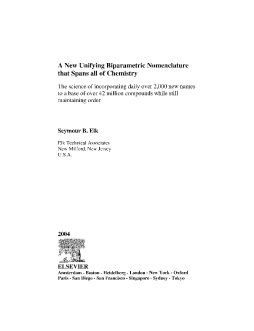
Additional Information
Book Details
Abstract
As a byproduct of historical development, there are different, unrelated systems of nomenclature for "inorganic chemistry", "organic chemistry", "polymer chemistry", "natural products chemistry", etc. With each new discovery in the laboratory, as well as each new theoretical proposal for a chemical, the lines that traditionally have separated these "distinct" subsets of matter continually grow more blurred. This lack of uniformity in characterizing and naming chemicals increases the communication difficulties between differently trained chemists, as well as other scientists, and greatly impedes progress. With the set of known chemicals numbering over 42,000,000 (in Chemical Abstracts' data base) and continually growing (about 2,000 new additions every day), the desirability for a unified system for naming all chemicals simultaneously grows. Moreover, in order to meet the requirements of disparate groups of scientists, and of society in general, the name assigned to a given chemical should, not only uniquely describe that substance, but also should be a part of a readily recognizable order for the entire field. For these purposes, a topology-based "bi-parametric" system of nomenclature is herein proposed.
- In this book, a new nomenclature system is proposed
- The new nomenclature is applicable to a three dimensional world, and is internally consistent
- This nomenclature unifies ALL branches of chemistry, removing the need for various presently existing sets of rules
"introduces a new systematic nomenclature system to provide uniformity. Criteria for nomenclature systems are described rigorously, and this system and existing systems are compared. Applications to a number of areas of chemistry are described in the remaining chapters. Compared to traditional nomenclatures, the system is more of a linear line notation that purports to fully describe the structure of chemical compounds."
R.E. Buntrock, University of Maine, CHOICE Magazine, April 2005
